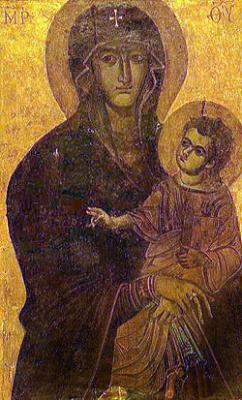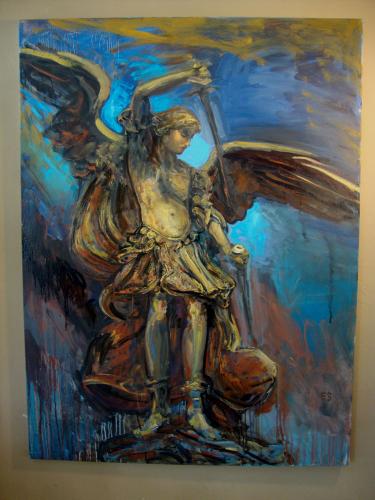The Retro future of Pope Francis
Cornelius Sullivan
|
13 September 2013

Santa Maria Solus Populi Romani
FLORIDA - Pope Benedict communicated with the depth of his intellectual discourse -- Pope Francis communicates with actions.
Pope Benedict's books, encyclicals and words, will provide inspiration for believers and also for all who cherish the truth for decades, even centuries to come. In the swirl of Vatican scandals the new Pope, Francis, emerged and showed right away that he possessed a special gift to communicate without words. Right after his selection as supreme Pontiff at the Conclave of 2013, he rode the bus with his compatriot Cardinals.
When serious Vatican writers focused on the problem of "Two Popes," Francis made it a no problem by going to visit Pope Emeritus Benedict at Castel Gandolfo. He kneeled with shoulders touching, as a brother, on the small kneeler to the side, while leaving the grander papal kneeler for the occasion in front of the altar, vacant. He has a genius for communicating without words. Perhaps heeding his mentor Saint Francis of Assisi who said; "preach the Gospel always, use words if you have to."
The world noted Pope Francis' simplicity, directness, and poverty, and understood that he was just what the Church needed, indeed, he was a Pope for this age. He has shown a readiness to not be needlessly restricted by tradition. Initially some mistakenly thought that this quality would make him more sympathetic to, for example, Liberation Theology ideas. He is not, in fact, he is very much in tune with the views of Pope John Paul II and Pope Benedict XVI on core doctrinal matters. But he is still viewed as new and forward looking.
Beginning his pontificate looking like a refreshing revolutionary he showed an intimate link with the rich devotional history of the Church in a pilgrimage visit the day after his election to the church of Santa Maria Maggiore, Saint Mary Major in Rome. He prayed in the Pauline Chapel named after Pope Paul V, the Borghese Chapel. The chapel houses, in great artistic splendor, an antique icon of the Virgin and Child, Santa Maria Salus Populi Romani, Mary, Protectress of the Roman people. Tradition attributes the icon to Saint Luke and says that Saint Helena, Constantine's mother, brought it to Rome from the east.
Pope Francis has called for a world wide weekend of prayer and fasting for peace; peace in Syria, in the Middle East, and in the world. A New York Times article by Elizabeth Dias chronicles Sunday's events.
" The prayer service began when four Swiss guards processed through the square with the icon Salus Populi Romani, Mary, the Queen of Peace and the Protectress of the Roman people. The Pope led the Rosary recitation, a meditation, and a Eucharist ceremony. Bible readings from the Gospel of Luke focused on Mary, and thousands of people in the square followed along with a 51-page booklet the Vatican produced for the service. Priests heard
confessions under the St. Peters colonnade." The icon of "Mary, Protectress of the Roman people" is also known as "Mary, the Queen of Peace."
The Times article goes on to say; "the World Council of Churches, the United States Conference of Catholic Bishops, and religious leaders around the world urged their followers to join the Pope’s call and spend Saturday in prayer. Catholics in Jerusalem met at the Church of Gesthemane. In Mumbai they gathered at the Cathedral of the Holy Name. A giant peace flag was also raised in Assisi, Italy, the hometown of Saint Francis, for whom Pope Francis is named."
What is extraordinary is that Pope Francis has connected with all people of peace, and he has reached the broad, global secular culture with this message, wrapped in very traditional Catholic devotional practices. Without convening a conference of interfaith leaders he has managed to get the Protestant World Council of Churches united in prayer with the Catholic Bishops and with religious leaders around the world. He has done it in his way, communicating by action.
There is a 60s peace march feel to the populous Pope's services for peace and calls for fasting and prayer. That imagined connection with the 60s is not what I meant with the word "retro." I was thinking much further back, very retro, sixth century. A more appropriate comparison can be made with the procession from Santa Maria Maggiore with the icon of the Virgin, Santa Maria Salus Populi Romani, by Pope Gregory the Great in 590 AD, with hundreds of pilgrims processing through the city to Saint Peter's Basilica. The prayers were to end the plague of that time. Almost at Saint Peter's, they all saw a vision of Saint Michael the Archangel above Hadrian's Tomb sheathing his sword, signifying that the plague would end. The same vision then occurred later at the same place, at the time of the Black Death; that mausoleum received its new name, Castel Sant'Angelo.
Pope Francis is a Pope for the people and acts in contrast to an elitism that has plagued the Church in recent times espousing the watered down liturgies of the 70s with sentiments in song of "I'm OK, you're OK" in guitar Masses. That elitism mistakenly eschewed traditional popular devotions. Like Pope Gregory, with the people, Pope Francis connects with the world while employing the time honored popular devotions; a procession, the Rosary, confessions, a Eucharistic celebration, and a piazza filled with prayers for peace.

Vision of St Michael the Archangel, oil, by the author


